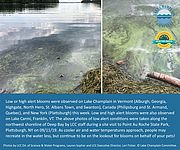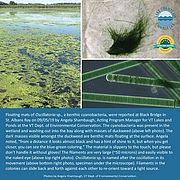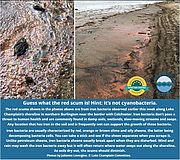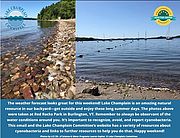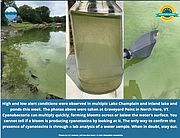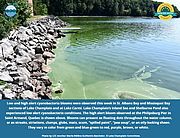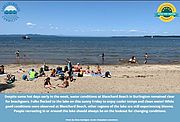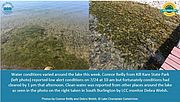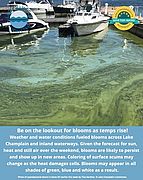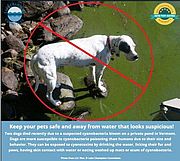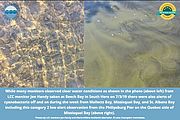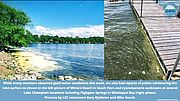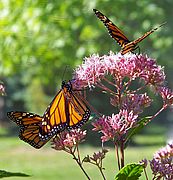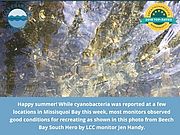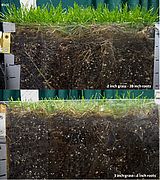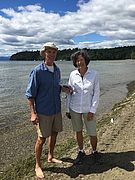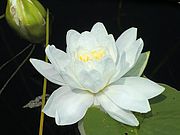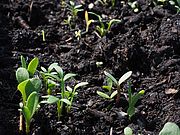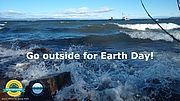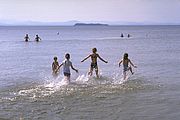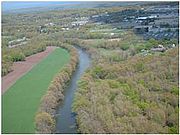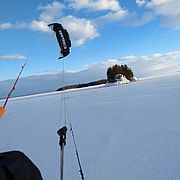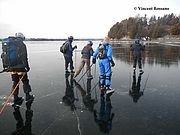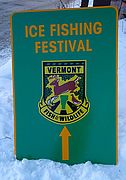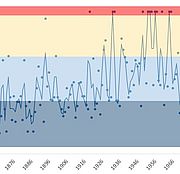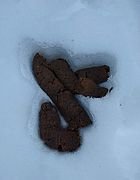Mixed conditions were reported again this week on Lake Champlain in Missisquoi Bay, St. Albans Bay, and the Inland Sea, and also at Lake Carmi. The floating mats of the benthic cyanobacteria Oscillatoria sp. that we showed you pictures of last week were still present at Black Bridge in St. Albans Bay on 9/10/19, but to a lesser extent. Monitors also observed mixed conditions in the Main Lake North section of Lake Champlain. Read...
News from Selected Month
Kids are back at school, seasonal staff are leaving beach and park areas, and there’s a hint of fall in the air this first week of September. However, cyanobacteria can still flourish even when autumn colors begin to show on the hillsides which is why the Lake Champlain Committee Cyanobacteria Monitoring Program continues through the end of October. Read...
It was another busy week for <link about-lcc>Lake Champlain Committee (LCC) monitors with alert level conditions reported from Lake Champlain’s Missisquoi Bay, St. Albans Bay, Inland Sea, Main Lake North, Main Lake South, and South Lake. Cyanobacteria was also reported at Colchester Pond, Lake Carmi, Lake Memphremagog, Nichols Pond, and Shelburne Pond. Bulwagga Bay Beach in Moriah NY was closed on Sunday August 25 due to a bloom but has since re-opened. Read...
We hope you’ve been enjoying the cooler temperatures and lower humidity this week. Here are results from our tenth week of the Lake Champlain Committee (LCC) cyanobacteria monitoring program. You’ll find resources and links to help you identify, report and avoid cyanobacteria. We’ve also included pictures of some of the conditions observed this week along with photos of a stick test you can use to help you differentiate cyanobacteria from non-toxin producing green algae. Please continue to share these resources with others to help educate people on water issues.
Read...
Alert level conditions were reported from several Lake Champlain locations and inland lakes this week including Lake Champlain’s inland sea, St. Albans and Missisquoi Bays and at Indian Brook Reservoir, Lake Carmi and Shelburne Pond. Scattered storms are predicted for the weekend before a rise in temperatures next week so pease be on the lookout for blooms and avoid contact with anything that looks suspicious. Read...
While there were many reports of generally safe conditions this week several sections of Lake Champlain as well as some inland waterways continue to be plagued by mixed conditions. Read LCC's latest report on cyanobacteria conditions for the week of 8/4/19. Read...
Lake Champlain Committee Monitors filed 177 reports this week! Blooms appeared in four Lake Champlain regions: Missisquoi Bay, St. Albans Bay, Inland Sea, and Main Lake Central. There were also bloom conditions at Lake Carmi and Shelburne Pond. Warm weather is predicted for this weekend. Please be on the lookout for blooms and avoid contact with anything that looks suspicious.
Over 216 reports were filed this week from Lake Champlain and inland waterways. Blooms were observed in all regions of Lake Champlain, except Malletts Bay and South Lake; Lake Carmi also had reports of cyanobacteria. Sun and heat are in the forecast for Saturday—be on the lookout for blooms!
Lake Champlain Committee monitors filed over 196 reports this week for Lake Champlain and inland waterways. While there were plenty of reports of clear water, blooms proliferated in parts of Missisquoi Bay, St. Albans Bay, the Inland Sea, Main Lake Central and Main Lake South. Shelburne Pond and Lake Carmi also had reports of cyanobacteria. Several beaches were closed in both New York and Vermont.
We saw a lot of volatility in conditions this week on Lake Champlain. Heavy rains flushed things out in some areas and in others provided additional nutrients to fuel cyanobacteria growth. Blooms showed up along the New York shoreline, in St. Albans Bay, Missisquoi Bay and along the Burlington and South Burlington shorelines and at Vermont inland waterways of Bald Hill Pond and Shelburne Pond. We also received word that two dogs recently died due to ingesting cyanobacteria from a private pond in Vermont. Please remind dog owners to be vigilant about protecting their pets and keep them away from water with cyanobacteria.
We had over 150 water quality observations from Lake Champlain and inland waterway monitors this week! Most were of good conditions but cyanobacteria was reported from Lake Champlain sites in Malletts Bay, St. Albans Bay and Missisquoi Bay. You’ll find further information and links below about cyanobacteria and how to recognize and report it. We’ve also included a photo of a mystery phenomena we are trying to identify (stay tuned for results next week) and a picture of the invasive fishhook waterflea. Populations of this aggressive, predatory zooplankton have increased dramatically since they were first discovered in Lake Champlain last September.
We had reports from 135 different sites this week with low alert sitings of cyanobacteria from Lake Champlain’s Missisquoi Bay, St. Albans Bay and Knapp Pond in Cavendish, VT. High alert bloom conditions persisted at Outer Malletts Bay on June 26 and 27 and improved to low alert conditions on Friday. Happily, most other monitors reported good conditions.
This article is a continuation of the fall 2018 article on raising Monarch butterflies for the fall migration. Both articles were written by Laura Pratt, LCC’s current ECO AmeriCorps Education & Outreach Coordinator, who raised monarchs in her home last year. Monarch butterflies are important pollinators in the Lake Champlain watershed. They rely on milkweed during their caterpillar stage – a plant which is growing scarce with an increase in urbanization and pesticide use. However, you can make a difference by planting native varieties of milkweed in your garden, encouraging your town to replace lawn with pollinator gardens where possible, and even by raising monarch butterflies yourself!
Happy start of summer! Cyanobacteria monitoring got underway earlier this week, toxin testing and phytoplankton analysis at selected shoreline locations on Lake Champlain will get underway next week as well. We are excited to have such a great crew of citizen scientists assessing water conditions! Low alert conditions were observed on the eastern side of Missisquoi Bay and some cyanobacteria was seen in the water at Niquette Bay State Park this week. All other areas of Lake Champlain along with inland Vermont lakes reported good conditions. Read...
Grass is the largest irrigated crop in the United States. It covers city parks, suburban lawns, and wide-open rural fields. Unfortunately, grass can be a major source of fertilizer runoff. While the best way to slow rainwater down and allow pollutants to settle out is to plant native grasses, shrubs, and trees instead of the traditional lawn, there are still things you can do to make your lawn green, healthy, and watershed friendly.
Help assess Lake Champlain water conditions around the lake. Complete our cyanobacteria monitor interest form if you're interested in monitoring or want to attend a training session to learn more about the lake. Feel free to share this invite with other lake lovers.
Spring isn’t just a time when trees and flowers are coming alive – plants are also opening up throughout the ponds, lakes, and waterways. While aquatic plants may look similar to their land-bound counterparts, they have evolved to endure an environment where light is often scarce and concentrations of atmospheric gases are low. These adaptions are clearly displayed in the variations between aquatic leaves.
Soil isn’t just the dirt we might think of when we wash our hands or take our shoes off at the door. Healthy soil is alive – it’s full of layered root systems, microbial communities, organic matter, worms, bugs, and fungi. It’s an entire ecosystem that powers all life above it. It can sequester carbon, hold water, and support healthy plant life – all of which are vital to turning the tide on climate change. And, most importantly for Lake Champlain’s water quality, soil with just a 1% increase in organic matter in the top six inches can hold over 20,000 gallons of water per acre.
Walk, run, hike, bike in the great outdoors. Breath some fresh air, get a little dirty or wet, take in the sunshine – or the rain (or snow), watch the stars. Commune with nature. Getting out into the greenery is known to brighten moods and improve health. To celebrate this year's Earth Day LCC has several ideas for going all out to enjoy and protect our environment!
Nestled between the Adirondacks and the Green Mountains, Lake Champlain is no stranger to cold, snowy winters. Wild ice – ice which forms naturally on lakes and ponds – is a special attribute of northern climes. Ice skating, skiing, show-shoeing, kiting, and fishing all rely on a thick layer of ice forming during the winter months. However, thaws can happen at any time during the ice season, and with climate change winter temperatures are becoming more unpredictable. Learn more about the stages of a thaw on lake ice, and how to stay safe throughout the winter.
LCC is looking to expand our photo stock of pictures for our articles, slideshows, social media, and website, and we need your help to do it! Whether it’s covered in ice or reflecting the summer sky, Lake Champlain is a stunning part of the natural landscape. From a beautiful vista, an unusual water phenomenon, or people exploring the lake, we welcome all of your photos. Submit your pictures of life on and around the water (swimming, fishing, skating, boating, natural history and more!) and help us share images of Lake Champlain in all its moods and magic.
Do you own property along a waterway in New York? Through the “Buffer in a Bag” initiative, New York State Department of Environmental Conservation’s (NYS DEC) Trees for Tribs Program and the NYS Tree Nursery will provide landowners with a free bag of 25 bare-root native trees and shrubs to enhance streamside areas of property. Riparian buffers – the term used to describe these vegetated shoreline zones – are vital to water quality. They allow stormwater to settle out before entering tributaries, which reduces pollution and sedimentation. They also provide wildlife habitat, prevent erosion, and increase the land’s ability to retain floodwaters.
Throughout the winter, Lake Champlain’s vast tracts of ice and snow provide the perfect conditions for snowkiters like Gary Kjelleren. A brand-new sport in the late 1990s, kitesailing (the summer version of snowkiting) quickly took off in popularity. A kitesailer uses a large sail-like kite to catch the wind, while they skim and jump over the water’s surface on a finned water board. Anyone who has spent time on the shores of a large lake or ocean is likely familiar with the colorful, crescent-shaped kites that swoop jauntily through the air, a small human figure skipping along behind them.
On December 19, 2018, LCC member Elizabeth Lee and four friends donned their cross country ski boots even though there was no snow on the ground. There was, however, ice -- wild ice that forms naturally on Lake Champlain. A cold few weeks had frozen some of the southern bays and the river-like strip of the South Lake, so Elizabeth and pals stepped onto Nordic skates and headed to Crown Point in the early morning light.
Knight Point State Park in North Hero was buzzing with people on the day of Vermont’s annual ice fishing festival, which was a particularly sunny Saturday in mid-January. The nice weather drew hundreds to the park in the first hours of the festival. Cars filled the parking lot and spilled out onto either side of the highway, several of them sporting out-of-state plates. People of all ages crowded around the registration table – groups of young college friends, parents dragging sleds full of equipment, toddlers so bundled against the cold that they waddled on the ice like penguins.
One of the best-understood facets of climate change is that global temperatures are rising overall. Since the turn of the 20th century we know that average temperatures have gradually risen every decade, and they will continue to rise more rapidly throughout the 21st century. Due to warming winter temperatures, Lake Champlain does not ice over as often as it did even 20 years ago. The freezeover that happened this month is now a rare and celebrated event. Read...
During winter, when the snow blankets the ground, dog owners may find it tempting to let sleeping dogs lie – and not clean up after them when they poop! After all, whether you’re walking in town or deep in the woods, what’s the harm in kicking a little snow over the stool and letting nature take its course?
If your faucet drips or your toilet runs it can waste over 10,000 gallons a year -- the amount of water in a typical backyard swimming pool. More than one trillion gallons of water are lost annually in the U.S. due to easy-to-fix household leaks. Read...
Teachers at J.J. Flynn Elementary School in Burlington, VT got creative in their World Water Day class project by partnering with Generator Makerspace, a non-profit in Burlington that bridges the intersection of art, science, and technology. With the technical support of Generator Makerspace, students learned to transform their drawings into laser-cut wood mosaics backed by colorful rice paper.
Plastics are everywhere. The stuff has made modern life possible, but more than 40% of plastics are designed for single use. Plastics are showing up in our waterways at an alarming rate, flushed down sinks and toilets in scrubbing agents, wet wipes and sanitary products; spun off as microfibers from clothes in the wash; and carried into waterways by wind and rain.
Read...
